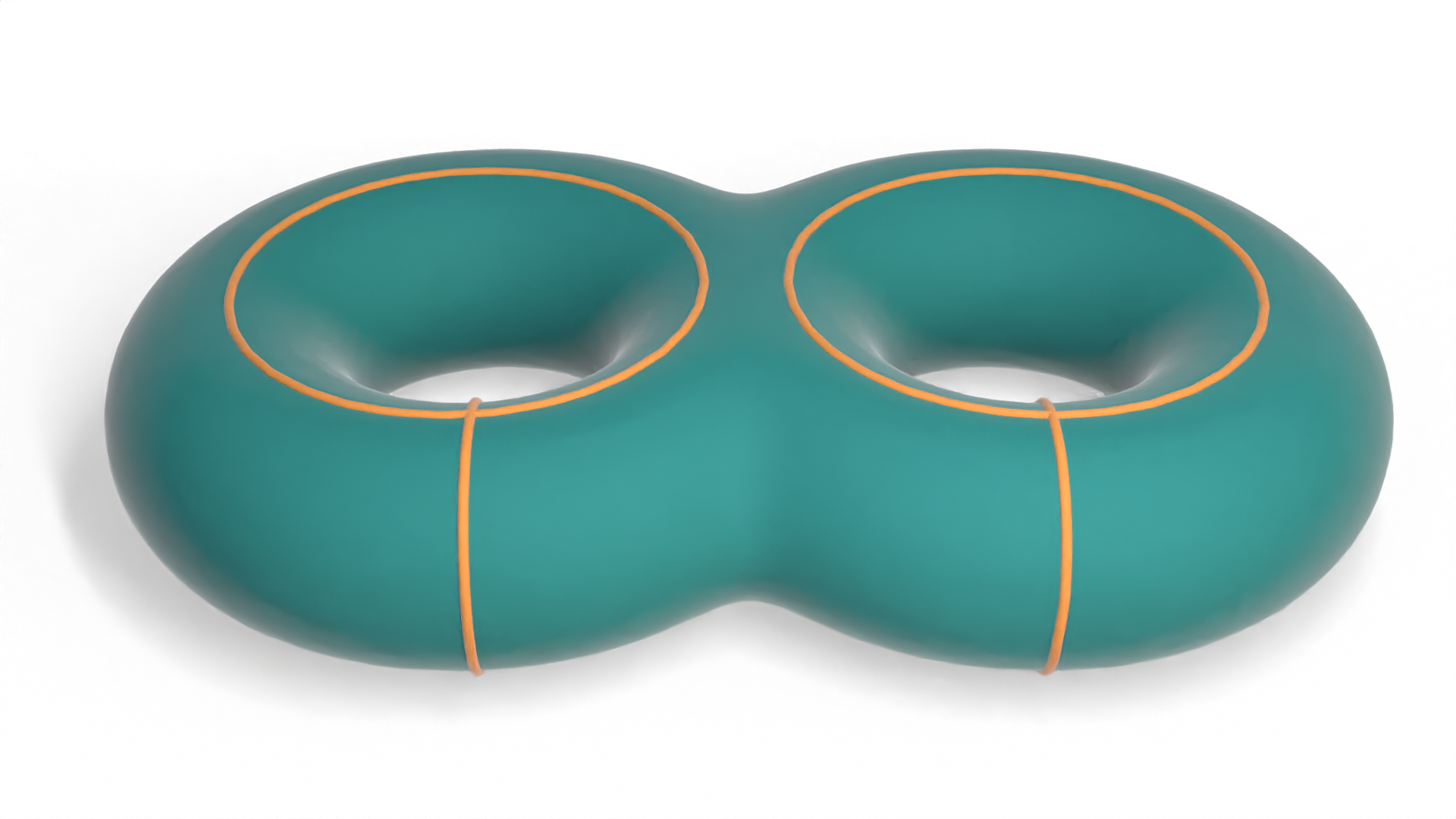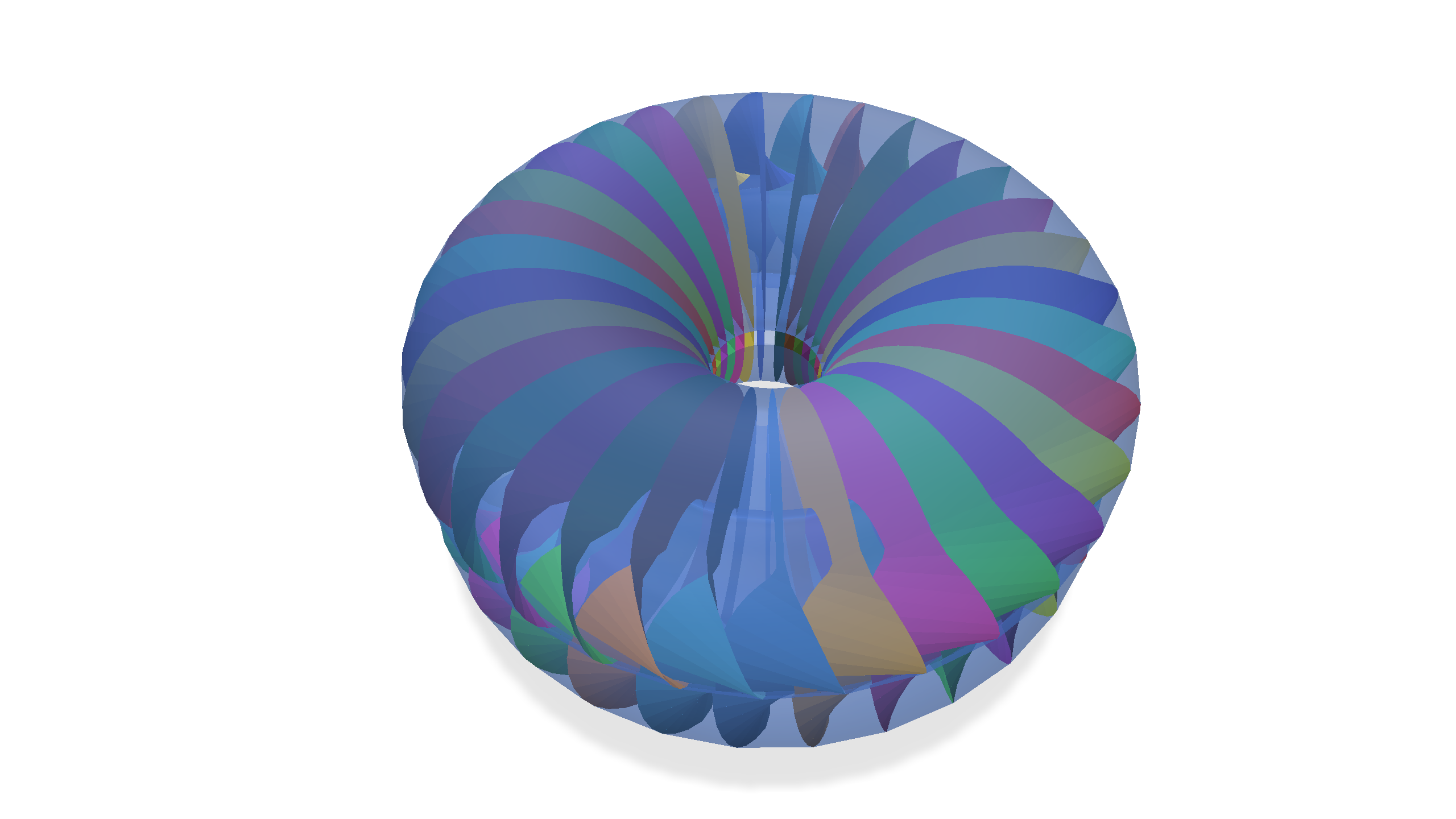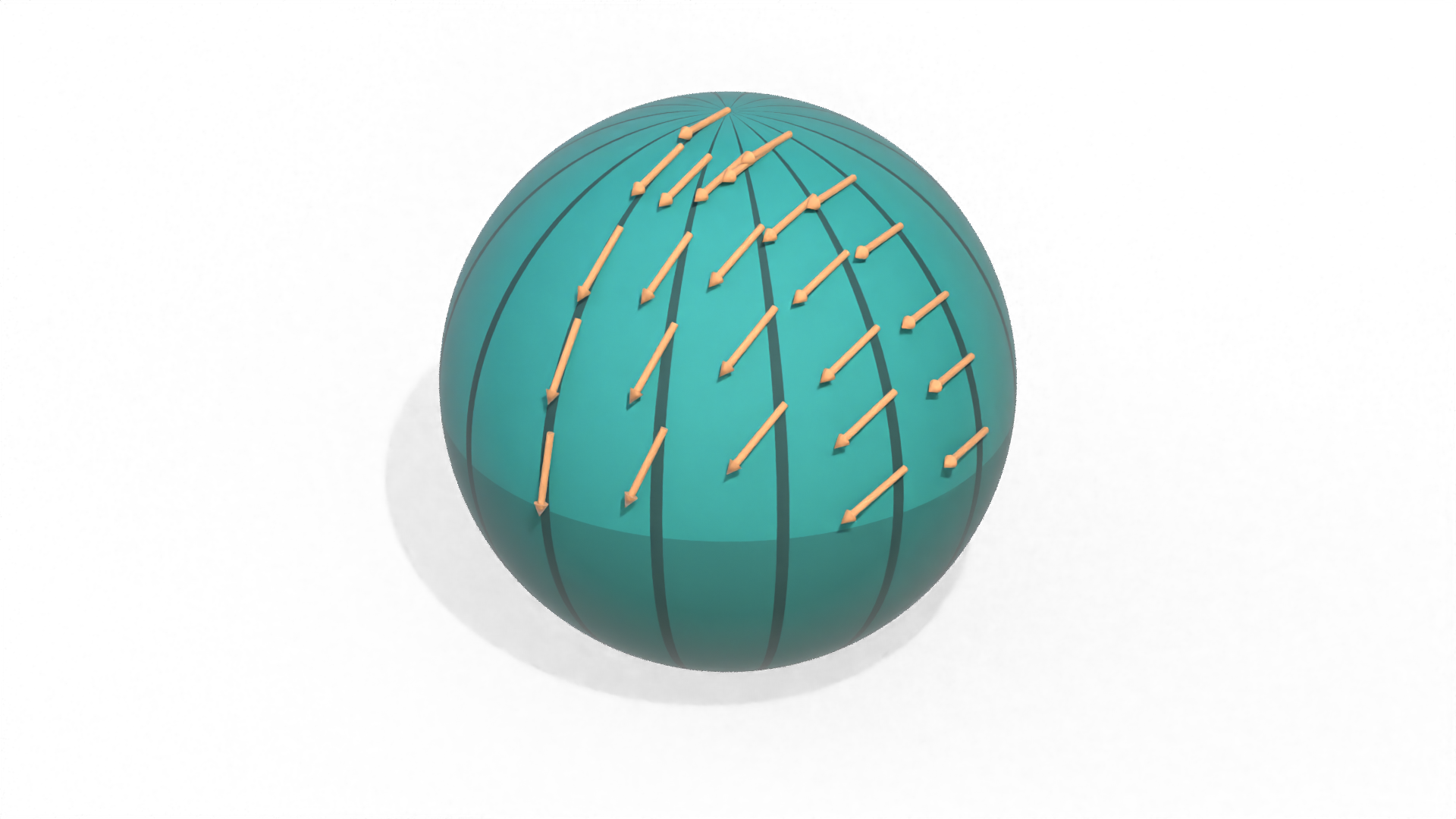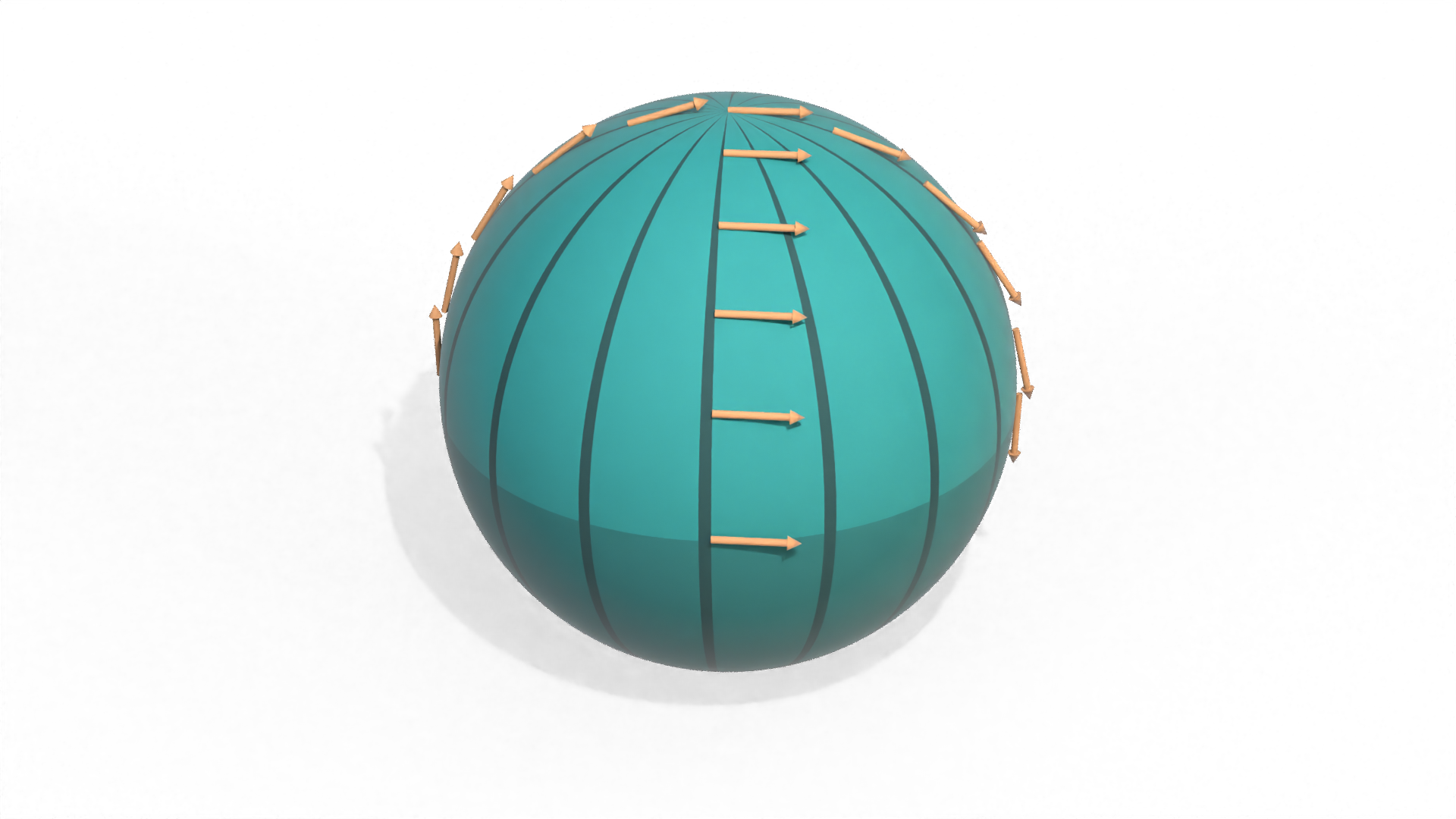The Galerkin Hodge star
Just as one can write down the \(L^2\) inner product between piecewise-linear basis functions to derive the scalar Galerkin mass matrix, one can also derive a Galerkin mass matrix for discrete 1-forms by taking inner products between their Whitney forms. The Whitney 1-form \(\varphi_{ij}\) on a triangle \(ijk\) is given by \[ \varphi_{ij} = \varphi_i d\varphi_j - \varphi_j d\varphi_i. \] The Whitney 0-form \(\varphi_i\) is given by the hat function at vertex \(i\), so its differential is \[ d \varphi_i = \frac{1}{2 A_{ijk}} \mathcal{J} e_{jk}, \] where \(e_{jk}\) is the edge vector pointing from vertex \(j\) to vertex \(k\).
Thus, the Whitney 1-form can be simplified to \[ \varphi_{ij} = \frac{1}{2A_{ijk}} \mathcal{J}\left(\varphi_i e_{ki} - \varphi_j e_{jk}\right). \] The inner product between \(\varphi_{ij}\) and \(\varphi_{jk}\) over triangle \(ijk\) is thus \[\begin{aligned} \langle\langle \varphi_{ij}, \varphi_{jk} \rangle\rangle_{ijk} &= \int_{ijk} \left\langle{\varphi_{ij}},{\varphi_{jk}}\right\rangle\;dA = \frac{1}{4A_{ijk}^2}\int_{ijk}\left\langle{\varphi_i e_{ki} - \varphi_j e_{jk}},{\varphi_j e_{ij} - \varphi_k e_{ki}}\right\rangle\;dA\\ &= \frac{1}{4A_{ijk}^2}\left(\left\langle{e_{ki}},{e_{ij}}\right\rangle\int_{ijk}\varphi_i\varphi_j\;dA - \left\langle{e_{jk}},{e_{ij}}\right\rangle\int_{ijk}\varphi_j^2\;dA\right.\\ &\hspace{2cm}\left. - \left\langle{e_{ki}},{e_{ki}}\right\rangle\int_{ijk}\varphi_i\varphi_k\;dA + \left\langle{e_{jk}},{e_{ki}}\right\rangle\int_{ijk}\varphi_j\varphi_k\;dA\right)\\ &= \frac{1}{4A_{ijk}^2}\left(\left\langle{e_{ki}},{e_{ij}}\right\rangle\frac{A_{ijk}}{12} - \left\langle{e_{jk}},{e_{ij}}\right\rangle\frac{A_{ijk}}{6} - \left\langle{e_{ki}},{e_{ki}}\right\rangle\frac{A_{ijk}}{12} + \left\langle{e_{jk}},{e_{ki}}\right\rangle\frac{A_{ijk}}{12}\right)\\ &= \frac{1}{48A_{ijk}}\left(\left\langle{e_{ki}},{e_{ij} + e_{jk}}\right\rangle - 2\left\langle{e_{jk}},{e_{ij}}\right\rangle - \left\langle{e_{ki}}{e_{ki}}\right\rangle\right)\\ &= \frac{1}{48A_{ijk}}\left(-\left\langle{e_{ki}},{e_{ki}}\right\rangle - 2\left\langle{e_{jk}},{e_{ij}}\right\rangle - \left\langle{e_{ki}},{e_{ki}}\right\rangle\right)\\ &= \frac{-1}{24A_{ijk}}\left(\|e_{ki}\|^2 + \left\langle{e_{jk}},{e_{ij}}\right\rangle\right)\\ &= -\frac{\ell_{ki}^2}{24A_{ijk}} + \frac{\ell_{jk}\ell_{ij}\cos\theta_j^{ki}}{12 \ell_{jk}{\ell_{ij}}\sin\theta_j^{ki}}\\ &= -\frac{\ell_{ki}^2}{24A_{ijk}} + \frac{1}{12}\cot\theta_j^{ki}, \end{aligned}\] where we have used the scalar finite element inner products \(\int_{ijk}\varphi_i \varphi_j\;dA = \tfrac{1}{12}A\) and \(\int_{ijk} \varphi_i^2\;dA = \tfrac{1}{6}A\).
Similarly, we can compute the inner product of \(\varphi_{ij}\) with itself as \[\begin{aligned} \langle\langle \varphi_{ij}, \varphi_{ij} \rangle\rangle_{ijk} &= \int_{ijk} \left\langle{\varphi_{ij}},{\varphi_{ij}}\right\rangle\;dA = \frac{1}{4A_{ijk}^2}\int_{ijk}\left\|\varphi_i e_{ki} - \varphi_j e_{jk}\right\|^2\;dA\\ &= \frac{1}{4A_{ijk}^2}\left(\|e_{ki}\|^2\int_{ijk} \varphi_i^2\;dA + \|e_{jk}\|^2\int_{ijk} \varphi_j^2\;dA - 2\left\langle{e_{ki}},{e_{jk}}\right\rangle\int_{ijk} \varphi_i \varphi_j\;dA\right)\\ &= \frac{1}{4A_{ijk}^2}\left(\|e_{ki}\|^2\frac{A_{ijk}}{6} + \|e_{jk}\|^2 \frac{A_{ijk}}{6} - 2\left\langle{e_{ki}},{e_{jk}}\right\rangle\frac{A_{ijk}}{12}\right)\\ &= \frac{1}{24A_{ijk}}\left(\|e_{ki}\|^2 + \|e_{jk}\|^2 - \left\langle{e_{ki}},{e_{jk}}\right\rangle \right)\\ &= \frac{1}{24A_{ijk}}\left(\|-e_{ij}\|^2 -2\left\langle{e_{ki}},{e_{jk}}\right\rangle - \left\langle{e_{ki}},{e_{jk}}\right\rangle \right)\\ &= \frac{1}{24A_{ijk}}\left(\|e_{ij}\|^2 -3\left\langle{e_{ki}},{e_{jk}}\right\rangle\right)\\ &= \frac{\ell_{ij}^2}{24A_{ijk}} + \frac{\ell_{ki}\ell_{jk}\cos\theta_k^{ij}}{4\ell_{ki}\ell_{jk}\sin\theta_k^{ij}}\\ &= \frac{\ell_{ij}^2}{24A_{ijk}} + \frac{1}{4} \cot\theta_k^{ij} \end{aligned}\]




















